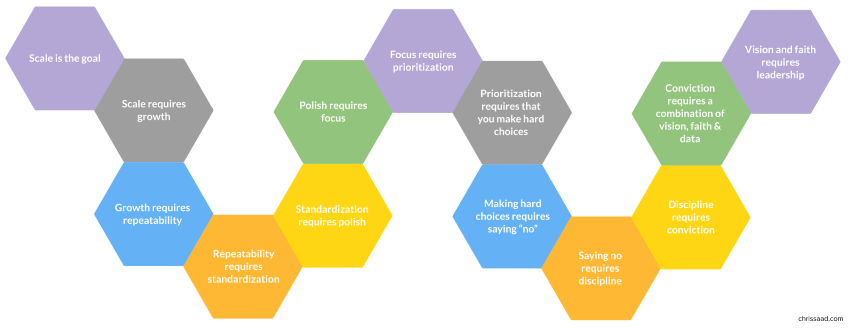When you don’t live in Silicon Valley, you appreciate the benefits of having someone like the former Head of Product at Uber Developer Platform resident in your hometown: Like being given access to Chris Saad’s latest scaling-up presentation, “Start-up Scale – A tactical guide to start-up focus, discipline and growth”, as part of BDO Australia’s “BDO for Start-ups” program.
At the outset, Chris noted that his presentation was meant to advise Silicon Valley-style, software-powered, tech-unicorn start-ups (think Facebook, Uber, Slack, etc.). Neverthless, I saw synergies for Way We Doers who also want to achieve scale in their businesses. The following diagram in particular struck a chord with me.

According to Chris Saad, “Achieving scale requires a sequence of interrelated decision and actions to be executed effectively.” (Source: www.chrissaad.com)
Scaling up is the goal
When talking about “scaling up”, Chris is referring to crazy-large businesses like Google, Facebook and the like – also known as “unicorns”. These businesses have low marginal rates because the costs of adding an extra user or customer is minuscule, compared to those in a traditional business. They focus on creating habit-forming features they can charge more for as they release new capability, thus growing the lifetime value of their users and creating economies of scale.
In my mind, scaling up is a goal a business’s founders have to define for themselves. Do you want to scale your business to run in multiple cities, states or countries? It’s your choice. Choose a scale-up goal that fits your vision.
And you don’t have to aspire to becoming the next Google to create a wonderful business. After all, unicorns are mythical creatures – not many companies are going to make it to the billion-dollar club. And there are more ways to manage a business’s worth to those involved with it. The “grow at any cost” mantra isn’t sustainable, and there are plenty of businesses that have taken this approach only to crash and burn.
A new movement has emerged that has taken an animal mascot – a real animal. Zebra businesses are ones that scale, but not at the pace of businesses like Uber who have created outsized returns. Online news platform, Quartz, defines a zebra as a company that:
“…focuses upon being a profitable business, that solves real, meaningful problems and in the process, repairs existing social systems. They are built with stamina and capital efficiency, as long as conditions allow them to survive.”
Living under the shadow of COVID-19 has investors more interested in zebras than unicorns, because sustainable businesses that generate cash trump those that don’t.
Scaling up requires growth, repeatability, and standardization
We’ve built Way We Do specifically to help businesses create repeatability and standardization into their operations so they can focus on customer service, and their own growth. For zebra and unicorn businesses alike, there is going to be a mix of low- and high-cost actions that will generate revenue. It makes good sense to lower costs and shorten lead times wherever you can, by taking advantage of available technologies. Things like allowing prospective customers to learn more about your business online, read and accept legal terms and conditions, and use self-service options to on-board with your services minimises variations and creates repeatability. Technology can readily play a part in every company’s processes to help them reduce the costs of doing business. I firmly believe that for traditional companies to survive in the long term, they must become “product/service + technology” organizations.
To suggest that unicorns don’t talk to their customers and don’t have costly, highly tailored actions is not true. Nearly every unicorn business has enterprise-level customers that need expensive resources, like sales development reps and business development managers, to close deals. There are certainly longer lead times involved. Some of these activities include calling customers, scoping and quoting on their requirements, legal reviews, signing contracts and more.
Custom development and pricing plans will increase costs – and should be avoided wherever possible in my opinion. Standardizing your product and service offerings creates repeatability, thereby lowering costs; standardization allows companies to scale.
When you’re bringing expensive resources – like sales reps – on board, having a standardized process for how to sell to, and service, customers is critical. If each sales person is selling in their own way, their results will be varied and unpredictable. Sales is an example of a process-oriented function. Document your standardized process and make sure your team is well trained, to reduce variability and boost repeatability.
Standardization also helps turn complex processes into simple ones, establishing a proven practice. What I love about the zebra metaphor is that they’re black and white, and the collective noun for a group of Zebras is a dazzle. The parallel is that standardization should be black and white – no ambiguity allowed – so your brand, your team, your products and services can dazzle your customers every time.
Standardization requires polish, focus and prioritization
Standardizing your processes is a complex undertaking and won’t necessarily mean things become simpler overnight. A complex process that has been standardized is still a complex process. Using business process management and Lean Six Sigma principles can help you simplify processes and reduce friction points over time. And adopting a continuous improvement culture will add the polish to your organization’s standards, along with proven ways of doing business.
Products and services need to be standardized for the market and customer segment you’re selling to. The trick is to focus on a niche of customers and use-cases. Chris Saad noted “Uber did not initially provide rides to everyone. They offered black cars to affluent people who needed to get to places fast (and) where cost was not a barrier.”
At Way We Do, we often talk about “process innovation”. You can further streamline legacy processes by disrupting them. Companies have the opportunity to remove, outsource, recreate, or automate steps of existing processes, or throw a process out and start again.
Unfortunately, we’re all time bound and we don’t always have the resources we need to implement everything we want to – no matter what size business we may have. After identifying which key processes you want to standardize, you’ll then need to prioritize them. Ideally, these will be the most important processes that, when standardized, will take your organization toward your scaling goals.
Hard choices, saying no and leadership
It can feel overwhelming when there are so many things to do, and you’re not sure which things will move needle in a positive direction. The emotional roller coaster of entrepreneurship is a tough one, but learning to make hard choices is paramount. Chris Saad recommended picking fewer focus areas and cutting others. This approach focuses the resources you do have into achieving your specific objectives, taking you closer to your goal.
Learning to say no and having the discipline to stick to those decisions can be equally difficult, but crucial. Without sticking to your guns, you won’t standardize, grow and scale.
The dilemma presented in saying “No” is a double edged sword: If you don’t say no, you may miss the revenue opportunity sitting in front of you, because you’re so busy saying yes to everything else. However, saying yes to the wrong things can create issues that waste time and money, along with team energy and morale.
Saying “No” to things that won’t help you scale, and sticking to those things you’ve committed to also takes strong leadership abilities. Wishy-washy leadership undermines businesses – and investors will only support those companies that deliver what they say they will.
Good leadership sets a vision that becomes the company’s north star, keeping the team motivated as you navigate them through the exercise of standardizing processes. However, you also need to back up this vision – and justify the trust your team is placing in your leadership – with data. As you progress through your standardization, keep testing, reiterating, learning and adapting to create truly effective processes.
2020 has been a year none of us could have anticipated, but by taking steps toward strategic planning, staying focused on your goals, and standardizing more of your business, you’ll be on a stronger path to scaling your business in 2021.





